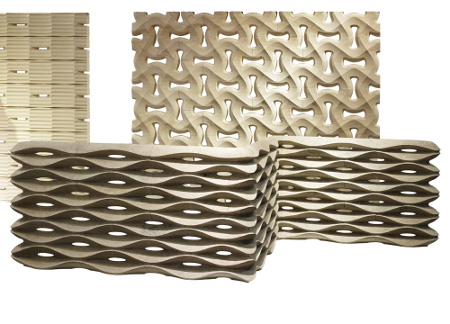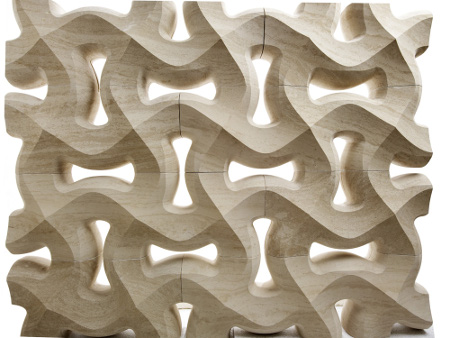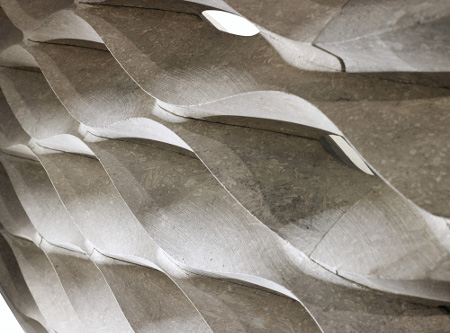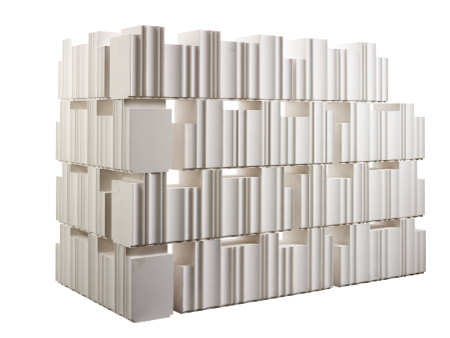4 Marzo 2013
English
Fold and Form*

Raffello Galiotto for Lithos Design, Muri di Pietra, Graffio, Traccia, Onda.
At first glance, without a vision of the whole, it may seem that the stone artefacts created for Lithos Design are the result of instantaneous inspiration, the gift of exceptional moments of creativity. However, contrary to appearances, they are the result of a long ‘interior subsidence’, the result of constant and, in part, semi-conscious work inspired by the designer’s confident willingness to embody the visionary nature of the new and unexplored.
If we observe the extension of all his creations in stone design, we note a permanent feature, an intriguing recurrence: the ‘fold’ that occurs both ‘above’ and ‘inside’ the material.
We think we can state that Raffaello Galiotto enhanced his creative path with the sign of the ‘fold’, not only as a formal event, but also as a complex and precise productive concept.
In carving, cutting and modelling the surface (or a whole block of stone) he folds the stone itself, creating energy in tension in an orientated, structural torsion.
The surface of the material shaped by transformation has the connotations of an ‘event’, which reveals the act of design and its processes. Its geometric feature gets ‘moving’, as if powered by plastic and elastic forces that are revealed and vibrate in the light. The fold determines the form and the fleeting and subtle depth of the stone, which can thus expose itself with mimetic irony, in an interplay of sculpting and smoothing, covering and uncovering, hiding and revealing itself, producing new shapes of alternating two and three dimensions which, at times, overlap and combine in the light and shade of a dynamic chiaroscuro.
Analogies multiply. A fold is, by definition, part of a surface, the point at which its straight direction is interrupted to form a more or less wide angle. Those things that produce one single fold are defined as simple (from the adverb semel, meaning once); while, on the other hand, those things which produce many are complicated. There are many composites and literal and figurative verbal derivatives of the act of ‘folding’, from the Latin, plicare and splicare, like unfolding, eliminating folds, applying, complicating, replicating, duplicating and amplifying. Many of these are linked to the translated sense of weaving a material or several materials, creating something interconnected or ‘implicated’.
A fold is also a timeless feature of stone. In geology, it is a malleable deformation that is plastic and uninterrupted in stratified rocky masses that originally lie horizontally in the depths of the earth, where the rock is imbued with a fold long before the hand of man can transform it.

Raffello Galiotto for Lithos Design, Muri di Pietra, Traccia.
[photogallery]galiottomuri1_album[/photogallery]
Raffaello Galiotto designs the surface of the material with an awareness of how much it influences our perception and identifies with the principle of sense, recognisability, identity and the representational nature of all forms. His idea of shaping is a constant and continuous experiment, not a definitive point of arrival, but a change into the next potential form.
The uninterrupted creative path, which is only rendered possible by the technological know-how of this young company from Vicenza that works with him, has resulted in two collections of particular value over the last year, although these are surely only temporary stages in its unstoppable production. After the repetitive complexity of the ‘Muri di Pietra’ collection, research into artefacts with a great deal of depth continued and was explored in more detail in the project with an archetypal name – because its very aim is to look to the origins – ‘Materia Litica’. On a different experimental front, the soft lines adopted as the profile of single material blocks of stone, are transformed into the plastic, textile nature of the elements in the ‘Drappi di Pietra’ collections.
Both systems (as they are complete constructive systems and not coverings) aim to create an all-consuming and multisensory space, allowing a strong physical and psychological characterisation of the constructed environment. Through the choice of stone, the structural composition of the elements lets one enter the space and experience it as ‘total design’.
Moving into the dimension of experiencing the space with the complicity of the body, Galiotto’s creations tend to produce a sensory experience that includes diversity, originality and surprise: features that have a strong analogy with the expression of what we could call ‘baroque’.
Far from evoking this definition as a label or a return to a ‘style’, we want to recognise the analogy with some aspects of a system of representation and taste, and capture how the formal richness, virtuosity and ability to identify and include fashions, decoration, rich details and formal fragments of the past (which survive the ebb and flow of time) – that of playing with the chiaroscuro effects of light on form – can create a dialogue with us, coexisting in the hybrid and omnivorous fusion of the contemporary.

Raffello Galiotto for Lithos Design, Muri di Pietra, Onda.
[photogallery]galiottomuri2_album[/photogallery]
To return to the ‘plastic-three dimensional’ value of the fold, we will apply the thoughts of Gilles Deleuze, a perspicacious and original philosopher, who defines the concept in his work of the same name1, based on the philosophical interpretation of another thinker (not by chance from the Baroque era), Leibniz. Baroque, according to Deleuze, curves and bends folds and, especially, (although folds are certainly not a new feature and have always existed in the history of representation) “takes them to infinity”. Finding in the fold the essence of Baroque, Deleuze reveals how this feature overcomes the boundaries of time and is a constant “fold upon fold”, even in the present day. For Deleuze a ‘fold’ is a metaphor: it is the formation of the soul and of modern conscience.
In the endless reproduction of folds, in their incessant stratification, which produces visual compositions, geometric relationships and ‘agreements’, we can see an analogy with Lithos Design’s unconventional vision of stone design.
In the collections produced with Raffaello Galiotto the graphic and geometric lines that make up the profiles contrast with the many folds that already exist in the history of figurative arts – Greek, Roman and Classical – those of fabrics and of modern day works, made possible by computer-assisted design which, as a result, crinkles, curves and folds stone.
This meeting with the rocky resource creates the magic spell.

Raffello Galiotto for Lithos Design, Muri di Pietra, Biblos.
In the transition of the two-dimensionality of design to the third dimension of physical-material reality, a fold can be repeated many times, can multiply (this also comes from the etymology of ‘fold’ in Latin) and be produced in a series, thanks to numerically controlled machine technology, in a potentially endless iteration.
Through a fold, a mechanical tool makes the endless extension of decoration – the iterative and continual composability of elements – possible, with the sophisticated, ‘Byzantine’ vocation of the material; an aptitude to become implicated in an endless woven tapestry that projects towards the ‘infinite’, or perhaps the ‘indefinite’. As well as direct references to forms of Western culture, the ornamentation of Galiotto’s surfaces leads the spectator to experience something similar to that where figures are repeated in identical forms, as in the aniconic tradition of the East, and offer themselves for contemplative, immobile fruition, aimed at enhancing the experience of interiorisation.
Note
1 Gilles Deleuze, La piega. Leibniz e il Barocco, Torino, Einaudi, 1988, pp. 228 (or. ed. Le pli. Leibniz et le Baroque, Paris, Les Éditions de Minuit, 1988).
